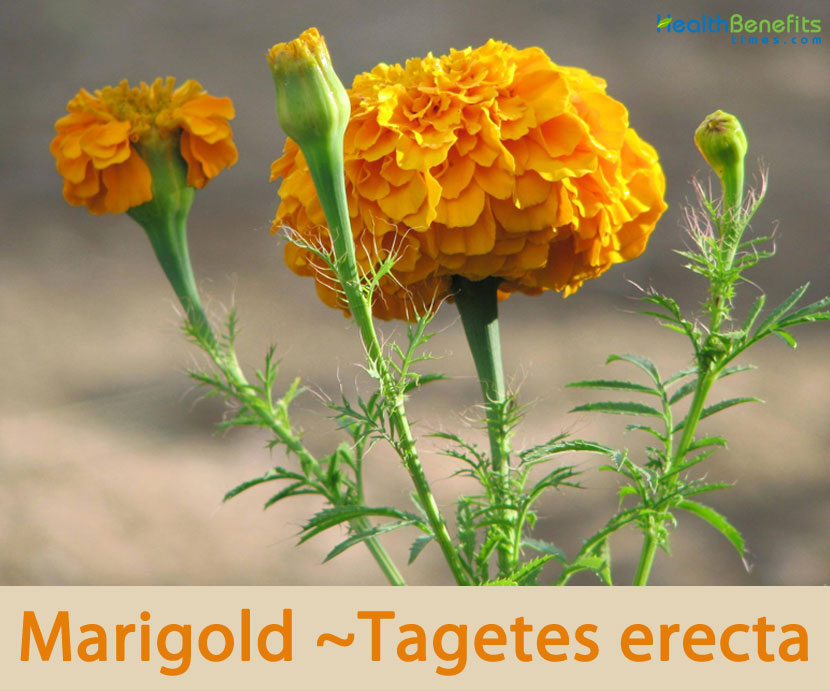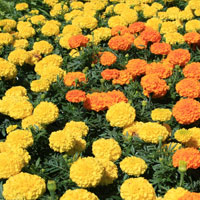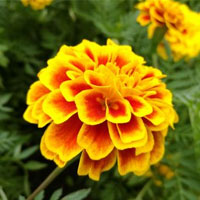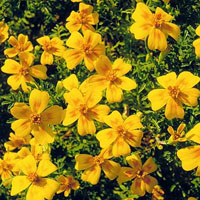| Marigold Quick Facts | |
|---|---|
| Name: | Marigold |
| Scientific Name: | Tagetes erecta |
| Origin | Central America, Mexico and Guatemala |
| Colors | Black |
| Shapes | Angular achene 7–10 mm long |
| Taste | Pungent, bitter, Astringent |
| Health benefits | Cancer Protection, Wound Healing,Treats Ulcers, Prevents Diseases, Arthritis, Vaginal Infections, Treats oily skin, Eczema and Allergies, Treat Health Ailments, Lowers free radical damage, Treatment of eye diseases, Boosting up immune system, Piles/Hemorrhoids, Ear infections, Lowers Inflammation and Free Radical Damage, Soothes Pains during Cramps and Spasms |
| Name | Marigold |
|---|---|
| Scientific Name | Tagetes erecta |
| Native | Central America, Mexico and Guatemala. It has been intentionally introduced across tropical, subtropical and temperate regions of the world and now it can be found cultivated and naturalized in North and South America, the Caribbean, Africa, Asia, Europe and Oceania |
| Common Names | African Marigold, American Marigold, Aztec Marigold, Big Marigold, Marigold, Mexican Marigold, Saffron Marigold, French marigold, Big marigold, Marigold, Mary Bud, Gold Bloom, Pot Marigold and Ruddes |
| Name in Other Languages | Afrikaans: Goudsbloem, Afrikaner Albanian: Kumak Amharic: Marigold Arabic: Aladhiriun naba’at (الآذريون نبات), makhmaliat qayima (مخملية قائمة) Armenian: Nargiz (նարգիզ), T’avshatsaghik ughghadzig (Թավշածաղիկ ուղղաձիգ) Assamese : Narji Phool (নাৰ্জী ফুল) Azerbaijani: həmişəbahar Basque: Marigold Belarusian: Kipciki (кіпцікі) Bengali: Gām̐dā phula(গাঁদা ফুল), Genda Brazil: Cravo de defunto Bosnian: Neven Bulgarian: Neven (невен) Catalan: Calendula Cebuano: Marigold Chichewa: Marigold Chinese: Wan Shou Ju (万寿菊), Wan Shou Ju Ye Chuukese: Peerang Corsican: Calendula Costa Rica: Manzanilla, rudillo Croatian: Neven Cuba: Chamberga, chambergo, clavelón, copete, copetuda Czech: Měsíček, Aksamitník vzpřímený Danish: Morgenfrue, Opret fløjlsblomst Dominican Republic: Caléndula, clavel de los muertos, clavel de muerto, copada Dutch: Goudsbloem, Afrikaantje Ecuador/Galapagos Islands: Arrayosa, sintzo English: African Marigold, African or French marigold, American marigold, Aztec marigold, French marigold, Big marigold, Marigold, Saffron marigold Esperanto: Marigold Estonian: Saialille, Kõrge Peiulill, madal peiulill Esperanto: Tageto, Taĝeto Filipino: Amarilyo Finnish: Kehäkukka, Isosamettikukka French: Souci, Tagète rose d’Inde, Oeillet d’Inde, Tagète Rose D’inde, tagete etalee Frisian: Goudsbloem Galician: Malmequer Georgian: Gulq’vitela (გულყვითელა) German: Ringelblume, Aufrechte Samtblume, Aufrechte Studentenblume, Studentenblume, Hohe Studentenblume Gom: Śinvti (ಶಿಂವ್ತಿ) Greece: Katifes Greek: Katifés (κατιφές), Tagétis o orthofyís (Ταγέτης ο ορθοφυής) Gujarati: Mērīgōlḍa (મેરીગોલ્ડ), galgoto (ગલગોટો) Haitian Creole: Tajèt, fleurs souci; souci Hausa: Marigold Hawaiian: Marigold Hebrew: Tspurni hkhsul (צִפּוֹרנֵי הַחָתוּל) Hindi: Gende ka phool (गेंदे का फूल), Genda, Hajara, Hajari, Hajri, Jhandu, genda (गेंदा) Hmong: Marigold Hungarian: Körömvirág, Nagy büdöske Icelandic: Gullfiskur Igbo: Marigold I–Kiribati: Te merikora Indonesian: Marigold Irish: Buí Italian: Calendula Jamaica: Marigold Japanese: Senju-Giku (センジュギク), Marīgōrudo (マリーゴールド) Javanese: Marigold Kannada: Mārigōlḍ (ಮಾರಿಗೋಲ್ಡ್), Chandu Hoo (ಚೆಂಡು ಹೂ), Chandu Mallige, Chendu Mallige (ಚಂಡುಮಲ್ಲಿಗೆ), Seeme Shavantige, Seemeshyaavanthige, Shraavanashyaavanthige, Seeme shaavantige (ಸೀಮೆಶಾವಂತಿಗೆ), Gonde gida (ಗೊಂಡೆಗಿಡ), Chendu hoo (ಚೆಂಡುಹೂ), chendu huvu (ಚೆಂಡು ಹೂವು) Kashmiri: Sadbargi (सद्बर्गी) Kazakh: Barqıt (барқыт) Khmer: Marigold Kinyarwanda: Marigold Konkani: Gondephool, Gondephool (गाँडेंफूल) Korean: Geumjanhwa (금잔화), Cheonsugug Kurdish (Kurmanji): Marîjok Kyrgyz: Marigold Lahaul: Bowdu Lao: Dok dav heuong (ດອກດາວເຮືອງ) Latin: Pingit vaccinia caltha Latvian: Kliņģerīte Lesser Antilles: Oeillets, yellow marigold Lithuanian: Serentis, gvazdikinis serentis Luxembourgish : Marigold Macedonian: Neven (невен) Malagasy: Marigold Malay: Marigold Malayalam: Jamanti (ജമന്തി), āphrikkan (ആഫ്രിക്കൻ) centumalli (ചെണ്ടുമല്ലി) Maltese: Marigold Manipuri: Sanarei, ꯁꯅꯥꯔꯩ Sanarei Maori: Arani, mērīkōro, merīkō, merīkōro Marathi: Zendu (झेंडू), Makh Mal, Makhamala, Rajiachaphul, Rajjachaphool, Roji, Thurukasaamanthi, Vedipu Naaripoo, Zendu Malli, Jhenduphool (झेंडूफूल) Mexico: Cempasúchil, cempaxochitl, cempoal, cempoalxóchitl, zanziltusus, zempoal, Flor De Muertos Mizoram: D-Erhken, Derhken Mongolian: Marigold (Мариголд) Myanmar (Burmese): Marigold Nahuatl: Cempōhualxōchitl Nepali: Marigold, Sayapatri (सयपत्री) Netherlands: Afrikaantjes Niuean: Melikolu Norwegian: Blomst Odia: Marigold Oriya: D-Erhken, Derhken, Mandyaphul, ଗେଣ୍ଡୁଫୁଲ, genduphula Panama: Amapola, clavellina Pashto: وږی Persian: گل همیشه بهار, جعفری گل درشتn, صد برگ sad barg Philippines : Ahito, Amarillo, Amarillo Polish: Nogietek, Aksamitka Wyniosła, Aksamitka Wzniesiona Portuguese: Calêndula, Cravo de defunto, Maravilha Puerto Rico: Clavelitos de muerto, ruda del pasto Punjabi : Mairīgōlaḍa (ਮੈਰੀਗੋਲਡ), gainda (ਗੈਂਡਾ) Romanian: Gălbenele Russian: Nogotki (ноготки), Barchatcy Prjamostojaščie Samoan: Marigold, Barkhattsy pryamostoyachiye (Бархатцы прямостоячие), makerita, sauga Sanskrit: Jhandu, Sthulapushpa, Zandu, Zanduga Scots Gaelic: Marigold Serbian : Neven (невен) Sesotho: Marigold Shona: Marigold Sindhi: مارگولڊ Sinhala: Marigold Slovak: Nechtík Slovašcina : Rumena Žametnica, Žametnica Rumena Slovencina : Aksamietnica Vzpriamená Slovenian: Ognjič Somali: Marigold Spanish : Maravilla, Flor de muerto, Cempasúchil, Zempoalxochitl, arrayosa, sintzo, clavel chino, clavel de muerto, clavelón de la India Sundanese: Marigold Swahili: Marigold, Tururu Swedish: Ringblomma, Stor tagetes, Stort sammetsblomster, Stor Tagetes Tajik: Marigold Tamil: Cāmanti (சாமந்தி), Banti, Kancappucceti, Totika, Totikavantippa, Tulukkaccevvanti, Tulukkamallikai, Tulukkuccevvanti, Turiyotacamanti, Kaṭṭik kēnti (கட்டிக் கேந்தி), kancappucceti (கஞ்சாப்பூச்செடி), tulukkaccevvanti (துலுக்கச்செவ்வந்தி) Telugu: Banthi (బంతి), chendumalle (చెండుమల్లె) Thai: Dao Ruang, Dxk dāwreụ̄xng (ดอกดาวเรือง), Dāwreụ̄xng (ดาวเรือง) Tatar: Marigolid (маригольд) Tongan: Melekoula Turkish: Kadife çiçeği Turkmen: Marigold Ukrainian: Nihtyky (нігтики) Urdu: میریگولڈ, گیندائے قائمہ, genda (گيندا), gul-e-ashrafi (گلِ اشرفی) Uyghur: Marigold Uzbek: Marigold Vietnamese: Hoa cúc, Cúc vạn thọ Welsh: Gold, gold talsyth Xhosa: Marigold Yiddish: Meragould (מעראַגאָולד) Yapese: Puarang Yoruba: Marigold Zulu: Marigold |
| Plant Growth Habit | Aromatic, erect branched, glabrous herbaceous annual or perennial plant |
| Growing Climates | Roadsides, ruderal sites, pastures, dry thickets, open fields, disturbed sites, mountain hills, savannas, pastures, shrub lands, tropical deciduous forests, thorny forests, cloud forests and pine-oak forests, shores, ponds, springs, quiet waters in streams, ditches, wetlands, wet meadows, waterside swamps and meadows |
| Soil | Thrives best in well-drained moderately fertile soil in a sunny position. Grows well in heavy clay soils and in sandy soils |
| Plant Size | 20 and 90 cm (7.9 and 35.4 in) |
| Root | Root is cylindrical, pivoting, with a fibrous and shallow branching system |
| Stem | Striated, sometimes ridged, smooth or slightly with villi, cylindrical, oval and herbaceous to slightly woody, with resin channels in the bark, which are aromatic when squeezed |
| Leaf | Opposite leaves at the bottom are alternate at the top, up to 20 cm long, pinnate, composed of 11 to 17 leaflets, lanceolate to linear-lanceolate, up to 5 cm long and 1.5 cm wide, acute to acuminate, serrated to sub-holders, the lower ones of each leaf frequently setiform (in the form of threads) |
| Flowering season | May until October |
| Flower | Marigold is usually yellow, orange, red and maroon in color. Each flower consists of large number of petals that overlap. Biggest petals are located on a periphery and smallest in a center of a flower. Flowers contain both male (stamen) and female (pistil) reproductive organs. |
| Fruit Shape & Size | Fruit an angular achene 7–10 mm long, black, glabrous to finely hispid, with pappus of basally connate scales |
| Fruit Color | Black |
| Varieties |
|
| Propagation | By Seed or by herbaceous cuttings |
| Flavor/Aroma | Strong, pungent odor |
| Taste | Pungent, bitter, Astringent |
| Plant Parts Used | Flower, leaves |
| Available Forms | Infusion, Powder, tincture, ointment, capsules |
| Lifespan |
|
| Health Benefits |
|
Plant Description
Marigold is an aromatic, erect branched, glabrous herbaceous annual or perennial plant that normally grows between 20 and 90 cm (7.9 and 35.4 in) tall. The plant is found growing in roadsides, ruderal sites, pastures, dry thickets, open fields, disturbed sites, mountain hills, savannas, pastures, shrub lands, tropical deciduous forests, thorny forests, cloud forests and pine-oak forests, shores, ponds, springs, quiet waters in streams, ditches, wetlands, wet meadows, waterside swamps and meadows. The plant thrives best in well-drained moderately fertile soil in a sunny position. It grows well in heavy clay soils and in sandy soils. Root is cylindrical, pivoting, with a fibrous and shallow branching system. Stem is striated, sometimes ridged, and smooth or slightly with villi, cylindrical, oval and herbaceous to slightly woody, with resin channels in the bark, which are aromatic when squeezed.
Leaves
Opposite leaves at the bottom are alternate at the top, up to 20 cm long, pinnate, composed of 11 to 17 leaflets. Leaflets are lanceolate to linear-lanceolate, up to 5 cm long and 1.5 cm wide, acute to acuminate, serrated to sub-holders. The lower ones of each leaf are frequently setiform (in the form of threads); the superiors are sometimes completely setiform; with abundant round glands. The margin is dentate and the leaf blade length is less than 2 inches and color of leaf is green. Foliage and flowers are aromatic when brushed or crushed.
| Leaf arrangement | opposite/sub opposite |
| Leaf type | odd-pinnately compound |
| Leaf margin | dentate |
| Leaf shape | oblong |
| Leaf venation | Not applicable |
| Leaf type and persistence | not applicable |
| Leaf blade length | Less than 2 inches |
| Leaf color | Green |
| Fall color | Not applicable |
| Fall characteristic | Not applicable |
Flowers
Flower-heads are borne singly, on stalks 3-10 cm. Flowers are usually yellow, orange, red and maroon in color. Each flower consists of large number of petals that overlap. Biggest petals are located on a periphery and smallest in a center of a flower. Flowers contain both male (stamen) and female (pistil) reproductive organs. Flowering normally takes place in between May until October.
The most useful parts of the Marigold flower are its heads and petals. People know and like this flower due to its bright yellow color and health benefits. Many varieties of the Marigold flower exist, like French marigold, Single Marigold, African marigold, and Triploids. Marigold flower also has its subtypes. Like other flowers, it is also rich in medicinal properties. You can find the flower easily everywhere, just search and use it to get the benefits.
| Flower color | Orange; yellow; golden; bicolored |
| Flower characteristic | Showy |
Fruits
Fertile flowers are followed by angular achene, about 7–10 mm long, black, glabrous to finely hispid, with pappus of basally connate scales.
History of Marigold
The history of Marigold begins with the Aztecs in Mexico, where these flowering plants were used as herbal medicine and in religious ceremonies. Later, the plant was taken to Spain, where the seeds were traded through Europe. It became popular in the churches in Spain and the name changed to Marigold. By the early 1900s, the importance of marigold flower increased when it became a part of the Burpee seed catalog after the company funded research on the plant and introduced new varieties. Today, the marigold flower is available in a variety of heavily scented and odor-free species.
Types of Marigold Flowers
Listed below are some of the popular Marigold varieties
1. African or American Marigolds (Tagetes erecta)
These marigolds are tall, erect-growing plants up to three feet in height. The flowers are globe-shaped and large. Flowers may measure up to 5 inches across. African Marigolds are very good bedding plants. These flowers are yellow to orange and do not include red colored Marigolds. The Africans take longer to reach flowering stage than the French type.
2. French Marigolds (Tagetes patula)
These Marigolds grow 5 inches to 18 inches high. Flower colors are red, orange and yellow. Red and orange bicolor patterns are also found. Flowers are smaller (2 inches across). French Marigolds are ideal for edging flowerbeds and in mass plantings. They also do well in containers and window boxes.
3. Signet Marigolds (T. signata ‘pumila’)
The signet Marigolds produce compact plants with finely divided lacy foliage and clusters of small, single flowers. They have yellow to orange colored, edible flowers. The flowers of signet marigolds have a spicy tarragon flavor. The foliage has a pleasant lemon fragrance. Signet Marigolds are excellent plants for edging beds and in window boxes.
4. Mule Marigolds
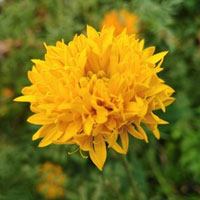 These marigolds are the sterile hybrids of tall African and dwarf French marigolds, hence known as mule Marigolds. Most triploid cultivars grow from 12 to 18 inches high. Though they have the combined qualities of their parents, their rate of germination is low
These marigolds are the sterile hybrids of tall African and dwarf French marigolds, hence known as mule Marigolds. Most triploid cultivars grow from 12 to 18 inches high. Though they have the combined qualities of their parents, their rate of germination is low
Health benefits of Marigold
Listed here are some of the well-known health benefits of marigold
1. Cancer Protection
According to the research done by The Journal of Nutrition, the antioxidants in marigolds help fight and prevent cancer. Researcher examined the effects of lutein, an antioxidant extracted from marigolds, on breast cancer tumors. The results of their study show that lutein not only reduced the number of tumors in the breast, it also prevented new cancer cells from developing. Researchers found that even in small dietary amounts, the lutein from marigolds had a positive effect. Marigold has also been found effective against leukemia, colon and melanoma cancer cells.
2. Wound Healing
Marigold is used traditionally in the area of wound healing. Rubbed on burns, scrapes and irritated skin, marigolds provide relief. When tested on rats, researchers in Brazil discovered that one of the mechanisms for wound healing comes from marigolds having the ability to promote the growth of new skin tissue, as well as new blood vessels that feed the skin. Researchers also state that marigold acts as an anti-inflammatory due to the presence of other compounds, including triterpenes and steroids.
3. Treats Ulcers
Drinking marigold extracts with clean drinkable water is known to be quite effective in treating painful mouth and stomach ulcers. Marigold extract tends to encourage lymphatic system which is why it can decrease swelling and cleanse toxins which may be contributing to ulcers.
4. Prevents Diseases
Marigold flower consists of high content of vitamin C which is a powerful antioxidant. Marigold flowers thus can be helpful in delaying or preventing cardiovascular diseases, cancer and strokes.
5. Arthritis
Marigold flowers have anti-inflammatory properties; they can provide relief from joint pain and arthritis. It is a common practice to use marigold extracts or oil for treating arthritis.
6. Vaginal Infections
Petals of marigold flowers can be used to prepare curing baths by boiling them for some time before adding them to warm water for bath. Adding them to the bath tub can heal vaginal infections, bladder infections and hemorrhoids.
7. Treats oily skin
Marigold flower is effective in treating oily skin. Soak fresh flowers in warm water and then apply them to the skin at least once a day. Leave it on for 10- 15 minutes before washing it off with water.
8. Eczema and Allergies
Marigold is used by people to treat eczema, bruising and allergic reactions. People who have oily complexions also use this flower to get rid of their oily complexion. For this, they apply the wet fresh flower and wash their face with water. Marigold flower can also save your eyes and avoid any diseases of the eye like cataract and many others.
9. Treat Health Ailments
Marigold flower can reduce acid in the digestive system and can help digest food minutes. People also use the flower of Marigold to treat warts and scabies. You cannot even have any allergic reaction or hormonal effect due to these Marigold flowers. So use this flower and become healthy.
10. Lowers free radical damage
Flowers of marigold consist of number of active chemicals which has been found to reduce the number of cells that are being damaged by the free radicals. At the same time, it also helps in fighting the growth of bacteria at the places where the skin is wounded.
11. Treatment of eye diseases
Marigold plays a vital role in the treatment of many eye diseases. It helps to reduce the inflammation of the eye, treatment of conjunctivitis and a number of other chronic ocular inflammatory conditions. It speeds up the treatment of the infections in the eyes.
12. Boosting up immune system
Extracts from marigolds are extremely helpful in managing the symptoms of the common cold; flu coughs fevers or sore throats. It greatly boosts the immune system of the body to a significant level.
13. Piles/Hemorrhoids
Nowadays, many people spend long hours sitting both on the job and at home, leading to development of various diseases such as piles/hemorrhoids. In such cases, you don’t have to look for expensive treatments in order to treat piles. You can use Marigold as part of your natural hemorrhoid treatment. For this, grind the yellow petals into paste form and apply the paste over the affected site. It will shrink the swollen veins that subsides the pain and swelling. Moreover, bleeding will also stop, regenerating the blood vessels to restore the normal integrity.
14. Ear infections
Marigold has natural antiseptic and antibacterial properties which are effective in treating microbial infections of the ear. If pus is present in the ear, first clear all the pus from the affected site and then put 2-3 drops of Marigold oil over it. The pus formation will be resolved in some days.
15. Lowers Inflammation and Free Radical Damage
Extracts that have been taken from the flower show a property to lower the C-reactive protein and cytokine levels in the body and guard the cells against being damaged by free radicals. This is one of the most basic causes of cell deterioration and aging. The Marigold flower not only controls the oxidative damage that is provoked by the free radicals in the body that can affect the fragile tissues of skin under eyes and other sensitive parts but also protect against infections of the skin, GI tract, and genitals caused by viruses or bacteria.
16. Soothes Pains during Cramps and Spasms
Marigold’s antispasmodic actions are beneficial for giving relief from muscle spasms, stomach cramps, “charley horse” pains and pre-menstrual cramps. It is able to decrease cramping by improving the circulation of blood to the painful area and reducing the inflammatory responses. Florets of Marigold can be consumed in the form of tea to help digestion internally and improve liver health or applied over the abdomen in ointment/extract form in order to seep into tense muscles through the skin.
Traditional uses and benefits of Marigold
- An infusion or decoction of the whole plant is taken internally for colds and respiratory ailments and as a stimulant in Mexico.
- Juice and leaves ground in water, are taken as an appetizer, aphrodisiac, diaphoretic, emetic, antipyretic, muscle relaxant, for liver problems, irregular menstrual flow, and dropsy (edema) in Mexico.
- Flower and leaf decoction is taken as a carminative to relieve colic and intestinal gas and as a diuretic.
- An ointment made from the leaves and juice and applied externally for malarial treatment.
- Whole plant infusion is taken for bronchitis and rheumatism, leaf infusion as vermifuge and a root infusion taken internally as a laxative in Brazil.
- Flower juice is taken internally as blood purifier and for piles, plant juice is used as ear drop and for eye infections, and a hot leaf poultice is used for boils and carbuncles in India.
- Flower is claimed to treat skin diseases like sores, burns, wounds, ulcers, eczema, and several other skin ailments.
- It is often used in sedation, depressurization, broadening bronchus, heat clearing and detoxicating, dissipating phlegm and stopping coughing, and spasmolysis and as an anti-inflammatory.
- It is extensively used for upper respiratory tract infection, whooping cough, conjunctivitis, oral cavity inflammation, odontalgia, pharyngitis, vertigo, children infantile convulsion, amenorrhea, blood stasis, stomach ache, ulcerative carbuncle and rheumatism, among others.
- Whole herb is anthelmintic, aromatic, digestive, and diuretic, emmenagogue, sedative and stomachic.
- It is used internally in the treatment of indigestion, colic, severe constipation, coughs and dysentery.
- Externally, it is used to treat sores, ulcers, eczema, sore eyes and rheumatism.
- Paste of the leaves is applied externally to treat boils, carbuncles and earaches.
- Decoction is used to treat colds, and mumps.
- It is applied externally to treat skin diseases, conjunctivitis and sore eyes.
- Leaves are used as an antiseptic agent and also used in kidney troubles and muscular pain.
- Flower is used to cure fever, epileptic fits according to Ayurveda.
- They are said to purify blood and flower juice is given as a remedy for bleeding piles and is also used in colds, rheumatism and bronchitis.
- The Cherokee used it as skin wash and for yellow dye.
- Aztecs used marigold for eye infections.
- In Brazil and Mexico, marigold used for joint pain and for muscular spasm.
- It is used in anemia, irregular menstruation, abdominal pain, muscular and bone pain.
- Paste of the leaf is fried in clarified butter or oil and consumed to control bleeding in piles and excessive blood flow during menstruation.
- Nasal administration of fresh juice of leaf is used to stop nose bleeding.
- Cold infusion of leaves and flowers is used to treat burning urination.
- Marigold cream is used to treat hemorrhoids as well as on infant bums to help fight diaper rash.
- Marigold flowers can be added to salads to add color and can be used as a substitute for saffron in recipes.
- Marigold Flower tea have been quite known particularly to American physicists, applying the herb to treat bruises, cuts and minor skin infections.
- Marigold is used topically in an ointment or salve to treat burns, bruises and cuts and fight infections that may occur with these conditions.
- Marigold tea is thought to aid in stomach upset and ulcers and help relieve menstrual cramps.
- It is used for anemia, irregular menstruation, abdominal pain during menstrual period, rheumatic muscular and bone pain.
- Leaves applied to boils and carbuncles; juice used for earaches.
- Infusion or decoction of plant used for colds, rheumatic pains, bronchitis.
- In Aztecs used for carbuncles and eye infections.
Culinary Uses
- Food colorant extracted from the petals of marigold flower is used in baked goods and baking mixes, beverages and beverage bases, breakfast Cereals, chewing gum, dairy product analogues, egg products, fats and oils, frozen dairy desserts and mixes, gravies and sauces, hard candy, infant and toddler foods, milk products, processed fruits and fruit juices, soft candy, fruit snacks, and soups and soup mixes.
- Marigold inflorescences have been utilized as lutein pigment source for food coloring, mainly of poultry skin and eggs.
- Petals of the flowers of some varieties can be eaten.
- The fresh receptacle is eaten by children.
- Yellow dye obtained from the flowers can be used as a saffron substitute for coloring and flavoring foods.
- The plant is used as a condiment.
Other Facts
- The plant is popular as a house and garden ornamental throughout most temperate countries.
- Flowers are used as a source of yellow fabric dye known as ‘egandai’ or ‘gendia’.
- Fresh flowers are also used as cut flowers.
- Fresh and dry flowers can be used to dye wool, silk and cellulose fibers into shades of golden-yellow to orange and olive-green to bronze, depending on the mordant used.
- Marigold meal and marigold extracts are used in poultry feed for coloring the skin, fat and egg yolks, and more rarely in aquaculture to feed fish (i.e., salmon) and crustaceans.
- Fresh and dry flowers are also used to dye wool, silk and cellulose fibers.
- The essential oil extracted from the plant is sometimes used in perfumery.
- The leaves are occasionally used as a condiment.
- Research also showed than essential oils extracted from Marigold are an effective insecticide against bed bugs.
- In Mexico, Central America, India and Nepal, the flowers are often used in ceremonies and religious rituals for decoration and for making garlands.
- In Mexico and Central America the flowers are used to decorate the altars in the celebration of All Saints Day.
- Water infused with the fragrant essential oil of the flower is used to wash corpses, and the flower is commonly planted in cemeteries in Honduras.
- In Mexico, it is used in the festivities of the Day of the Dead, to decorate altars and tombs; hence the name “flowers of the dead”.
- In Nepal and India, flowers are often sold in local markets and used as an offering to the Gods.
- All parts of the plant emit an unpleasant smell similar to that of stale urine when they are bruised.
- The marigold was regarded as the flower of the dead in pre-Hispanic Mexico and is widely used in the Day of the Dead celebrations.
- Tagetes species are often used in companion planting for tomato, eggplant, chili pepper, tobacco, and potato.
- Marigolds are used in garlands and decoration for weddings, festivals, and religious events.
- Essential oils extracted from the marigold are used in cosmetic industry for the production of creams and lotions.
- Marigold in a diet of chickens leads to incorporation of lutein into the eggs and facilitates treatment of macular degeneration.
- Dried Marigold flowers are often added to dream pillows to help bring prophetic dreams and increase luck.
Precautions
- It can trigger ragweed allergy, which is considered one of the main seasonal allergies and is caused by contact with the plants or pollen from Asteraceae species, such as marigolds and sunflowers.
- Symptoms include eye irritation, sneezing, runny or stuffy nose, itchy throat and ears, and difficulty breathing.
- Pregnant and breastfeeding women are advised to consult a health professional before using marigold preparations.
References:
http://www.theplantlist.org/tpl1.1/record/gcc-3913
https://www.itis.gov/servlet/SingleRpt/SingleRpt?search_topic=TSN&search_value=38483#null
http://www.hear.org/pier/species/tagetes_erecta.htm
https://npgsweb.ars-grin.gov/gringlobal/taxon/taxonomydetail?id=36197
https://pfaf.org/USER/Plant.aspx?LatinName=Tagetes+erecta
https://www.cabi.org/isc/datasheet/52641
http://www.missouribotanicalgarden.org/PlantFinder/PlantFinderDetails.aspx?taxonid=277371
https://plants.usda.gov/core/profile?symbol=TAER
https://en.wikipedia.org/wiki/Tagetes_erecta
http://wgb.cimmyt.org/gringlobal/taxonomydetail.aspx?id=36197
https://www.flowersofindia.net/catalog/slides/Marigold.html
http://www.efloraofgandhinagar.in/herb/tagetes-erecta


